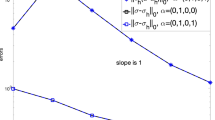Abstract
In this paper we propose a novel way to prescribe weakly the symmetry of stress tensors in weak formulations amenable to the construction of mixed finite element schemes. The approach is first motivated in the context of solid mechanics (using, for illustrative purposes, the linear problem of linear elasticity), and then we apply this technique to reduce the computational cost of augmented fully-mixed methods for thermal convection problems in fluid mechanics, in the case where several additional variables are defined. We show that the new approach allows to maintain the same structure of the mathematical analysis as in the original formulations. Therefore we only need to focus on ellipticity of certain bilinear forms, as this property provides feasible ranges for the stabilization parameters that complete the description of augmented methods. In addition, we present some numerical examples to show that these methods perform better than their counterparts that include vorticity, and emphasize that the reduction in degrees of freedom (and therefore, in computational cost) does not affect the quality of numerical solutions.




Similar content being viewed by others
References
Adams, S., Cockburn, B.: A mixed finite element for elasticity in three dimensions. J. Sci. Comput. 25, 515–521 (2005)
Almonacid, J.A., Gatica, G.N.: A fully-mixed finite element method for the Boussinesq problem with temperature-dependent parameters. Comput. Methods Appl. Math. (2019). https://doi.org/10.1515/cmam-2018-0187
Almonacid, J.A., Gatica, G.N., Oyarzúa, R.: A mixed-primal finite element method for the Boussinesq problem with temperature-dependent viscosity. Calcolo 55(3), 36 (2018)
Almonacid, J.A., Gatica, G.N., Oyarzúa, R., Ruiz-Baier, R.: A new mixed finite element method for the \(n\)-dimensional Boussinesq problem with temperature-dependent viscosity. Preprint 2018–18, Centro de Investigacion en Ingenieria Matematica (\(\text{CI}^2\text{ MA }\)). Universidad de Concepcion, Chile (2018)
Alvarez, M., Gatica, G.N., Gomez-Vargas, B., Ruiz-Baier, R.: New mixed finite element methods for natural convection with phase-change in porous media. J. Sci. Comput. 80(1), 141–174 (2019)
Arnold, D.N., Brezzi, F., Douglas, J.: PEERS: a new mixed finite element for plane elasticity. Japan J. Appl. Math. 1, 347–367 (1984)
Arnold, D.N., Falk, R.S., Winther, R.: Differential complexes and stability of finite element methods. II. The elasticity complex. In: Arnold, D.N., Bochev, P.B., Lehoucq, R.B., Nicolaides, R.A., Shashkov, M. (eds.) Compatible Spatial Discretizations. IMA Vol. Math. Appl., vol. 142, pp. 47–67. Springer, New York (2006)
Arnold, D.N., Falk, R.S., Winther, R.: Finite element exterior calculus, homological techniques, and applications. Acta Numer. 15, 1–155 (2006)
Arnold, D.N., Falk, R.S., Winther, R.: Mixed finite element methods for linear elasticity with weakly imposed symmetry. Math. Comput. 76(260), 1699–1723 (2007)
Arnold, D.N., Winther, R.: Mixed finite elements for elasticity. Numer. Math. 92(3), 401–419 (2002)
Artioli, E., de Miranda, S., Lovadina, C., Patruno, L.: A stress/displacement virtual element method for plane elasticity problems. Comput. Methods Appl. Mech. Eng. 325, 155–174 (2017)
Artioli, E., de Miranda, S., Lovadina, C., Patruno, L.: A family of virtual element methods for plane elasticity problems based on the Hellinger–Reissner principle. Comput. Methods Appl. Mech. Eng. 340, 978–999 (2018)
Boffi, D., Brezzi, F., Fortin, M.: Reduced symmetry elements in linear elasticity. Comm. Pure Appl. Anal. 8, 1–28 (2009)
Camaño, J., Oyarzúa, R., Ruiz-Baier, R., Tierra, G.: Error analysis of an augmented mixed method for the Navier–Stokes problem with mixed boundary conditions. IMA J. Numer. Anal. 38(3), 1452–1484 (2018)
Colmenares, E., Gatica, G.N., Oyarzúa, R.: Analysis of an augmented mixed-primal formulation for the stationary Boussinesq problem. Numer. Methods Partial Differ. Equ. 32(2), 445–478 (2016)
Colmenares, E., Gatica, G.N., Oyarzúa, R.: An augmented fully-mixed finite element method for the stationary Boussinesq problem. Calcolo 54(1), 167–205 (2017)
Fraejis de Veubeke, B.X.: Stress function approach. In: World Congress on the Finite Element Method in Structural Mechanics, Bournemouth (1975)
Gatica, G.N.: Analysis of a new augmented mixed finite element method for linear elasticity allowing \(\mathbb{RT}_0-\mathbb{P}_1-\mathbb{P}_0\) approximations, M2AN Math. Model. Numer. Anal. 40(1), 1–28 (2006)
Gatica, G.N.: An augmented mixed finite element method for linear elasticity with non-homogeneous Dirichlet conditions. Electron. Trans. Numer. Anal. 26, 421–438 (2007)
Gatica, G.N.: A Simple Introduction to the Mixed Finite Element Method: Theory and Applications. Springer Briefs in Mathematics. Springer, Cham (2014)
Gatica, G.N., Márquez, A., Meddahi, S.: An augmented mixed finite element method for 3D linear elasticity problems. J. Comput. Appl. Math. 231(2), 526–540 (2009)
McLean, W.: Strongly Elliptic Systems and Boundary Integral Equations. Cambridge University Press, New York (2000)
Pechstein, A., Sch\(\ddot{{\text{ b }}}\)erl, J.: Tangential-displacement and normal–normal-stress continuous mixed finite elements for elasticity. Math. Models Methods Appl. Sci. 21(8), 1761–1782 (2011)
Pechstein, A., Sch\(\ddot{\text{ b }}\)erl, J.: An analysis of the TDNNS method using natural norms. Numer. Math. 139(1), 93–120 (2018)
Stenberg, R.: A family of mixed finite element methods for the elasticity problem. Numer. Math. 53, 513–538 (1988)
Author information
Authors and Affiliations
Corresponding author
Additional information
Publisher's Note
Springer Nature remains neutral with regard to jurisdictional claims in published maps and institutional affiliations.
This research was partially supported by CONICYT-Chile through the project AFB170001 of the PIA Program: Concurso Apoyo a Centros Científicos y Tecnológicos de Excelencia con Financiamiento Basal, and Fondecyt project 1161325; by Centro de Investigación en Ingeniería Matemática (\(\hbox {CI}^2\)MA), Universidad de Concepción; and by the Oxford Centre for Doctoral Training in Industrially Focused Mathematical Modelling.
Rights and permissions
About this article
Cite this article
Almonacid, J.A., Gatica, G.N. & Ruiz-Baier, R. Ultra-weak symmetry of stress for augmented mixed finite element formulations in continuum mechanics. Calcolo 57, 2 (2020). https://doi.org/10.1007/s10092-019-0351-2
Received:
Revised:
Accepted:
Published:
DOI: https://doi.org/10.1007/s10092-019-0351-2
Keywords
- Mixed finite element methods
- Ultra-weakly imposed symmetry
- Linear elasticity
- Boussinesq equations
- A priori error estimates




